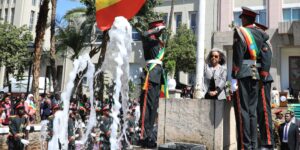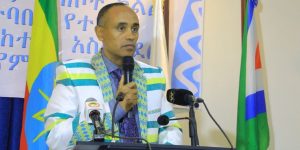Regarding FALASHAS, native Jewish sect of Ethiopia. First off, know that “Falasha” (Amharic for “stranger”, “moved” or “gone into exile”, “exiles” or “landless ones”) is considered very derogatory. The Falashas themselves refer to their sect as Beta Yisrael. Just say “Ethiopian Jew” if you can’t remember “Beita Yisrael.” (“House of Israel”). There are 4 principle theories of their origins, not all of them mutually exclusive.
1) The Beita Yisrael may be the lost Israelite tribe of Dan.
2) They may be descendants of Menelik I, son of King Solomon and Queen Sheba.
3) They may be descendants of Ethiopian Christians and pagans who converted to Judaism centuries ago.
4) They may be descendants of Jews who fled Israel for Egypt after the destruction of the First Temple in 586 BCE and eventually settled in Ethiopia.
The origin of the Beita Yisrael is unknown. One Beita Yisrael tradition claims to trace their ancestry to Menelek, son of King Solomon of Israel and the queen of Sheba. Some scholars place the date of their origin before the 2d century BC, largely because the Beita Yisrael are unfamiliar with either the Babylonian or Palestinian Talmud. The Bible of the Beita Yisrael is written in an archaic Semitic dialect, known as Gecez , and the Hebrew Scriptures are unknown to them.
![]() The religion of the Beita Yisrael is a modified form of Mosaic Judaism unaffected generally by post-biblical developments. The Beita Yisrael retain animal sacrifice. They celebrate scriptural and no scriptural feast days, although the latter are not the same as those celebrated by other Jews. One of the Falasha non-scriptural feast days, for example, is the Commemoration of Abraham. Their Sabbath regulations are stringent. They observe biblical dietary laws, but not the postbiblical rabbinic regulations concerning distinctions between meat and dairy foods. Marriage outside the religious community is forbidden. Monogamy is practiced, marriage at a very early age is rare, and high moral standards are maintained.
The religion of the Beita Yisrael is a modified form of Mosaic Judaism unaffected generally by post-biblical developments. The Beita Yisrael retain animal sacrifice. They celebrate scriptural and no scriptural feast days, although the latter are not the same as those celebrated by other Jews. One of the Falasha non-scriptural feast days, for example, is the Commemoration of Abraham. Their Sabbath regulations are stringent. They observe biblical dietary laws, but not the postbiblical rabbinic regulations concerning distinctions between meat and dairy foods. Marriage outside the religious community is forbidden. Monogamy is practiced, marriage at a very early age is rare, and high moral standards are maintained.
The centre of Beita Yisrael religious life is the masjid, or synagogue. The chief functionary in each village is the high priest, who is assisted by lower priests. Falasha monks live alone or in monasteries, isolated from other Beita Yisrael . Rabbis do not exist among the Beita Yisrael .
Regarding their early historical origins, and the route by which their Judaic tradition reached them, no direct written records survive. Most scholars however; believe that the Beita Yisrael came to Ethiopia in the early part of the First Century after the destruction of the 2nd Temple. (Not to be confused with the destruction of the 1st Temple during the Babylonian captivity) These scholars believe that the Beita Yisrael migrated from Southern Arabia or Egypt and converted and intermarried with the Ethiopians. In support of their Egyptian origins is the intriguing fact that the Jewish Temple Temple on Elephantine, probably begun by Jews fleeing the destruction of Jerusalem in 586 BCE and recorded in letters with the Jewish Temple in the Persian period lost its standing with those in Jerusalem. In 410 B.C. the Temple was destroyed by the Egyptians and an Egyptian temple was built over it.![]() It is possible that Jewish refugees from Elephantine may have sought sanctuary in Ethiopia. This may explain why these Jews performed blood sacrifices outside the Temple, are unfamiliar with the writings of the Prophets and the Talmud, and do not celebrate Hanukkah or Purim. The Bible claims that it was during the reign of King Josiah (who ruled during the mid 600s BC) that blood sacrifice outside the Temple was abolished. It was also after this period that the holidays Hanukkah and Purim began, although these are both more probably post 2nd Temple reforms lent authenticity by attributing it to “Good King” Josiah.
It is possible that Jewish refugees from Elephantine may have sought sanctuary in Ethiopia. This may explain why these Jews performed blood sacrifices outside the Temple, are unfamiliar with the writings of the Prophets and the Talmud, and do not celebrate Hanukkah or Purim. The Bible claims that it was during the reign of King Josiah (who ruled during the mid 600s BC) that blood sacrifice outside the Temple was abolished. It was also after this period that the holidays Hanukkah and Purim began, although these are both more probably post 2nd Temple reforms lent authenticity by attributing it to “Good King” Josiah.
Other Researchers think some of the defeated Yemenite Jews from the Abu Duwas Jewish Kingdom came to Ethiopia. However, it is generally accepted that “Christianity”, in some form, reached Ethiopia (then the kingdom of Aksum) in the 4th century; and that a “Judaic” presence probably preceded it. The Falasha ancestors, however, were probably local Agew peoples in Ethiopia who were converted by Jews living in southern Arabia in the centuries before and after the start of the Christian Era.
In 331 AD, King Ezana of Ethiopia converted to Christianity. The Ethiopians where quick to embrace the faith. The Ethiopian Christians are Orthodox Christians, also referred to as Abyssinian Christians. The Abyssinians and the Beita Yisrael shared many of the same traditions. Circumcision, the food customs of Leviticus and the Saturday Sabbath. These are still practiced by many Abyssinian Christians today. The Falasha remained faithful to Judaism after the conversion of the powerful Ethiopian kingdom of Aksum to Christianity in the 4th century AD, and thereafter the Falasha were persecuted and forced to retreat to the area around Lake Tana, in northern Ethiopia.
The relationship between the two religious traditions, at that time both in a state of development and change, is complex; and the Ethiopian Orthodox Church has until now retained many “Judaic” aspects. It is possible that the Ethiopian Jews received their tradition from those (known as “ayhud”, = “Jews”) who either refused to accept Christianity or who rebelled against it, and who withdrew, or were exiled, to the remote mountainous regions of Semien and beyond.
![]() According to their oral traditions, they formerly had an independent “Falasha” kingdom in Semien, with a dynasty of rulers named Gedewon. They fought a series of wars against the armies of the Amhara emperors who aimed to subdue them and convert them to Christianity. In the seventh century with the spread of Islam, Ethiopia is isolated from most of the Christian world. The Beita Yisrael enjoyed a period of independence before the power struggles of the middle ages. The numbers of Jews in Ethiopia may also have been increased by the expulsion of all non Muslim faiths from the Arabian subcontinent.
According to their oral traditions, they formerly had an independent “Falasha” kingdom in Semien, with a dynasty of rulers named Gedewon. They fought a series of wars against the armies of the Amhara emperors who aimed to subdue them and convert them to Christianity. In the seventh century with the spread of Islam, Ethiopia is isolated from most of the Christian world. The Beita Yisrael enjoyed a period of independence before the power struggles of the middle ages. The numbers of Jews in Ethiopia may also have been increased by the expulsion of all non Muslim faiths from the Arabian subcontinent.
The earliest apparent reference to the Beita Yisrael appears in the diary of Eldad Hadani, a merchant and traveller claiming to have been a citizen of an autonomous Jewish state in eastern Africa inhabited by the tribes of Dan, Naftali, Gad, and Asher.
The Solomonic dynasty (which claims decent from Solomon and Sheba) assumed control in Abyssinia. During the next 300 years (1320-1620), intermittent wars are fought between the Christian kings of Ethiopia and those of the Beita Yisrael, which finally result in the Beita Yisrael’s loss of independence. During the reign of Emperor Minas (1559-1563) that the move of the imperial capital from Shawa to the Lake Tana area, brought the imperial rulers into more direct contact with some of the more important areas of Falasha settlement in and around the high and rugged Samen mountains. Minas’s brother, the great Emperor Sarsa Dengel, also known as Malak Sagad (1563-1597), had a Falasha, or probably more correctly ex-Falasha wife from Samen. She is believed to have been a sister of , the notable Beita Yisra’el ruler of Samen. She is referred to in the royal chronicles of the time by the title Emabet or Tegazanyi (honorific titles perhaps the equivalent to Princess), and is variously called Harago or Haragwe, perhaps an abbreviation of Haraga Amlak, i.e. Creeper, or Plant, of God. Emabet Harago, was not the Emperor’s first or principal wife: Sarsa Dengel’s official consort was Maryam Sena, a woman of Orthodox Christian descent. Harago, we would reiterate, was nevertheless a woman of by no means negligible status: in part because of her believed descent from the ruling Falasha dynasty, and in part because of her apparently long-standing relationship with the Emperor, which caused her to bear him at least four sons.
After Sarsa Dengel’s death in 1597, the lords and members of the royal family duly assembled, and agreed among themselves to make Ya’qob, Emabet Harago’s son, emperor. To forestall any opposition from Za-Dengel, Sarsa Dengel’s nephew, also a rival claimant to the throne and thus once again ousted from the succession, they seized him before he heard of his uncle’s demise. They then took him as a prisoner to the island of Deq on Lake Tana, whence he was later transferred to a place of detention on one of the mountains of Gojjam, which was impossible of access without a rope.
Ya’qob, whose capital was at Qoga, east of Lake Tana, reigned, according to the royal chronicle, for seven years. Not long after his accession, Ras Atenatwos, the husband of one of Sarsa Dengel’s daughters by Maryam Sena, and governor of Begemider province, came to the capital, and established himself as the young Emperor’s “tutor”, or in effect his master.
In the sixth year of his reign Ya’qob, however, succeeded in freeing himself from this tutorage. He fought an armed battle with Atenatwos, defeated him, and later replaced him as his political mentor by another lord, a Gurage chief called Ras Za-Sellase. Yaqob’s relations with the latter, however, soon deteriorated. The young Emperor then lost the support of the army, which rebelled. The soldiers, condemning him as a foolish child, interested only in his games, joined Za-Sellase in deposing him.
Ya’qob at around this time was accused of various other crimes. These included adultery, betraying the Christian religion, breaking a cross on the church of Beta Iyasus, and consulting cow’s fat, like the “Gallas” (or Oromos), for purposes of prophecy. In view of his mother’s Falasha background the three latter charges, unsubstantiated and probably false as they were, are not without interest.
After his overthrow the young Emperor was taken to Enarya province in the south-west of the empire where he was kept as a prisoner. He was replaced as Emperor by Sarsa Dengel’s nephew Za-Dengel, who was at last given the throne which his uncle had, as we have seen, apparently earlier wished to grant him.
The reign of Za-Dengel’s was, however, but a short one. In the course of a rebellion not long after his accession he died, or was killed, in October 1606, reportedly on account of a horse accident, for , the chronicle says, “he did not know the art of riding, but only poetry and hymns”.
The death of Za-Dengel, like that of so many other Ethiopian rulers, was followed by much political confusion, in the course of which the Gurage chief Za-Sellase is said by the chronicle to have “held the realm in his hands”. Realising the need for the speedy appointment a new Emperor , however, he decided on restoring Ya’qob to the throne.
The young half-Falasha ex-Emperor, by then about fifteen years’ old, was accordingly recalled from Enarya, and again placed on the throne. To consolidate his power he effected a dynastic marriage with the daughter of the ruler of Hadeya, long an important source of gold, but, according to Almeida, had no time to carry out the wedding ceremony.
The Beta Yisra’el country, despite its proximity, was, however, far from easy of access, or conquest. Christians finally conquered the Ethiopian Jewish Kingdom in 1622 following 300 years of warfare. The vanquished Jews are sold as slaves, forced to baptize, and denied the right to own land. In 1624, the Beita Yisrael fought what would be their last battle for independent autonomy against Portuguese-backed Ethiopians, when the emperor Susenyos utterly crushed them and confiscated their lands.. ![]() A graphic eyewitness account described the battle: “Falasha men and women fought to the death from the steep heights of their fortress… they threw themselves over the precipice or cut each other’s throats rather than be taken prisoner—it was a Falasha Masada. [The rebel leaders] burned all of the Falasha’s written history and all of their religious books, it was an attempt to eradicate forever the Judaic memory of Ethiopia”. The Beit Yisrael were finally defeated in the early 17th century. Both in their own traditions and in Ethiopian written chronicles there are accounts of heroism and self-sacrifice, of men and women throwing themselves to death from mountain-tops rather than submit to conversion.
A graphic eyewitness account described the battle: “Falasha men and women fought to the death from the steep heights of their fortress… they threw themselves over the precipice or cut each other’s throats rather than be taken prisoner—it was a Falasha Masada. [The rebel leaders] burned all of the Falasha’s written history and all of their religious books, it was an attempt to eradicate forever the Judaic memory of Ethiopia”. The Beit Yisrael were finally defeated in the early 17th century. Both in their own traditions and in Ethiopian written chronicles there are accounts of heroism and self-sacrifice, of men and women throwing themselves to death from mountain-tops rather than submit to conversion.
In 1769 Scottish explorer James Bruce awakens the western world to the existence of the Ethiopian Jews in his travels to discover the source of the Nile. He estimates the Jewish population at 100,000. Daniel Ben Hamdya, an Ethiopian Jew, in 1855 independently travelled to Jerusalem to meet with rabbis, followed in 1864 by Rabbi Azriel Hildesheimer, the Rabbi of Eisenstadt, Germany, publishing a manifesto in the Jewish press calling for the spiritual rescue of Ethiopian Jewry. Three years later Professor Joseph Halevy is the first European Jew to visit the Beita Yisrael, subsequently becoming an advocate for the community. Over 5 centuries, Beita Yisrael had declined in numbers from several hundred thousand (perhaps even half a million) to 35,000.
They had fought and given their lives to keep their distinctive tradition and identity, and to prevent their assimilation into the dominant Amhara Christian culture. Nevertheless, they absorbed much of that culture, including its language.
They lived alongside their fellow Ethiopians and shared a common economy: they tilled the land, ploughed and sowed and raised their crops; tended their livestock; worked at their crafts and trades. They were skilled craftsmen: potters, weavers, blacksmiths and metal-workers, builders. Their conditions improved in the late 19th and 20th centuries, at which time tens of thousands of Falasha lived in the region north of Lake Tana. Falasha men are traditionally ironsmiths, weavers, and farmers. Falasha women are known for their pottery .As a specialist occupational group, they were an integral and essential part of Ethiopian society, and participated in its life and history.
Little additional contact was made with the community, but in 1935 their stability was greatly threatened as the Italian army marched into Ethiopia. Ethiopia’s ruler, Emperor Haile Selassie fled his country and actually took refuge in Jerusalem for a short time. Selassie returned to power in 1941, but the situation for the Beta Israel improved little.
Under Haile Selassie I, a few Beita Yisrael rose to positions of prominence in education and government, but reports of persecution followed the emperor’s ouster in 1974.
In 1956, Ethiopia and Israel established consular relations, which were improved in 1961 when the two countries established full diplomatic ties. Positive relations between Israel and Ethiopia existed until 1973 when, in the wake of the Yom Kippur War, Ethiopia (and 28 African nations) broke diplomatic relations with Israel under the threat of an Arab oil embargo.
Months later, Emperor Selassie’s regime ended in a coup d’etat. Colonel Mengistu Haile Mariam, whose Marxist-Leninist dictatorship increased the threat to the Beta Israel, replaced Selassie. During the weeks surrounding Mariam’s coup, an estimated 2,500 Jews were killed and 7,000 became homeless.
Soon Mariam instituted a policy of “villagization”: relocating millions of peasant farmers onto state-run cooperatives. This policy greatly harmed the Beta Israel by forcing them to “share” their villages (even though they were denied the right to own the land) with non-Jewish farmers, resulting in increased levels of anti-Semitism throughout the Gondar Province. According to the Ethiopian government, over 30% of the population had been moved from privately owned farms to cooperatives as of 1989.
![]() After taking office in 1977, Israeli Prime Minister Menachem Begin was eager to facilitate the rescue of Ethiopia’s Jews, and so Israel entered into a period of selling arms to the Mariam government in hopes that Ethiopia would allow Jews to leave for Israel. In 1977, Begin asked President Mengistu to allow 200 Ethiopian Jews to leave for Israel aboard an Israeli military jet that had emptied its military cargo and was returning to Israel. Mariam agreed, and that may have been the precursor to the mass exodus of Operation Moses began.
After taking office in 1977, Israeli Prime Minister Menachem Begin was eager to facilitate the rescue of Ethiopia’s Jews, and so Israel entered into a period of selling arms to the Mariam government in hopes that Ethiopia would allow Jews to leave for Israel. In 1977, Begin asked President Mengistu to allow 200 Ethiopian Jews to leave for Israel aboard an Israeli military jet that had emptied its military cargo and was returning to Israel. Mariam agreed, and that may have been the precursor to the mass exodus of Operation Moses began.
In the early 1980’s, Ethiopia forbade the practice of Judaism and the teaching of Hebrew. Numerous members of the Beta Israel were imprisoned on fabricated charges of being “Zionist spies,” and Jewish religious leaders, Kesim, were harassed and monitored by the government.
The situation remained exceedingly bleak through the early 1980’s. Forced conscription at age 12 took many Jewish boys away from their parents, some never to be heard from again. Additionally, with the constant threat of war, famine, and horrendous health conditions (Ethiopia has one of the world’s worst infant mortality rates and doctor to patient ratios), the Beta Israel’s position became more precarious as time progressed.
The government began to slightly soften its treatment of the Jews, however, during the mid-1980’s when terrible famines wreaked havoc on the economy. Ethiopia was forced to ask Western nations for famine relief, including the United States of America and Israel, allowing them both to exert a modicum of pressure for the release of the Beta Israel.
Over 8,000 Beta Israel came to Israel between 1977 and 1984. But these efforts pale in comparison with the modern exodus that took place during 1984’s Operation Moses.
From 1980 to 1992 some 45,000 Falasha fled drought- and war-stricken Ethiopia and emigrated to Israel. The number of Falasha remaining in Ethiopia was uncertain, but estimates ranged to only a few thousand. The ongoing absorption of the Falasha community into Israeli society was a source of controversy and ethnic tension in subsequent years.
Many Beit Yisrael in the centuries of persecution had to leave Ethiopia and migrated to places like Egypt, the Sudan Ghana, Nigeria etc, where they maintained an independent ethnic identity. It is understood that the Cape Verdian Falash Mura were sent to the island of Anguilla during the Atlantic Enslavement Trade. Grandparents of people alive today practiced their religion secretly and spoke some Hebrew, and many stories of the Beita Yisrael having to hide and convert to Christianity were told.
It is understood that large communities of Falash Mura or Beita Yisrael are in Curacao, Statia, St. Martin./St. Maarten, the U.S. Virgin. Islands, Jamaica etc. From there they may have influenced the development of Rastafarianism.
To be continued
Ethiopia Autonomous Media
- Lideta Sub City Woreda celebrated International Women’s Day - 11th March 2024
- THE AMHARA FANO FREEDOM FIGHTERS - 13th February 2024
- GREAT VICTORY FROM SHOWA GOVERNORATE - 12th February 2024










